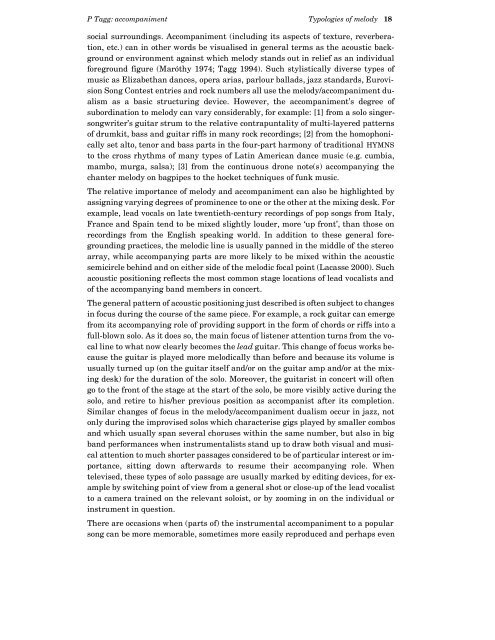Melody and Accompaniment - Philip Tagg
Melody and Accompaniment - Philip Tagg
Melody and Accompaniment - Philip Tagg
You also want an ePaper? Increase the reach of your titles
YUMPU automatically turns print PDFs into web optimized ePapers that Google loves.
P <strong>Tagg</strong>: accompaniment Typologies of melody 18<br />
social surroundings. <strong>Accompaniment</strong> (including its aspects of texture, reverberation,<br />
etc.) can in other words be visualised in general terms as the acoustic background<br />
or environment against which melody st<strong>and</strong>s out in relief as an individual<br />
foreground figure (Maróthy 1974; <strong>Tagg</strong> 1994). Such stylistically diverse types of<br />
music as Elizabethan dances, opera arias, parlour ballads, jazz st<strong>and</strong>ards, Eurovision<br />
Song Contest entries <strong>and</strong> rock numbers all use the melody/accompaniment dualism<br />
as a basic structuring device. However, the accompaniment’s degree of<br />
subordination to melody can vary considerably, for example: [1] from a solo singersongwriter’s<br />
guitar strum to the relative contrapuntality of multi-layered patterns<br />
of drumkit, bass <strong>and</strong> guitar riffs in many rock recordings; [2] from the homophonically<br />
set alto, tenor <strong>and</strong> bass parts in the four-part harmony of traditional HYMNS<br />
to the cross rhythms of many types of Latin American dance music (e.g. cumbia,<br />
mambo, murga, salsa); [3] from the continuous drone note(s) accompanying the<br />
chanter melody on bagpipes to the hocket techniques of funk music.<br />
The relative importance of melody <strong>and</strong> accompaniment can also be highlighted by<br />
assigning varying degrees of prominence to one or the other at the mixing desk. For<br />
example, lead vocals on late twentieth-century recordings of pop songs from Italy,<br />
France <strong>and</strong> Spain tend to be mixed slightly louder, more ‘up front’, than those on<br />
recordings from the English speaking world. In addition to these general foregrounding<br />
practices, the melodic line is usually panned in the middle of the stereo<br />
array, while accompanying parts are more likely to be mixed within the acoustic<br />
semicircle behind <strong>and</strong> on either side of the melodic focal point (Lacasse 2000). Such<br />
acoustic positioning reflects the most common stage locations of lead vocalists <strong>and</strong><br />
of the accompanying b<strong>and</strong> members in concert.<br />
The general pattern of acoustic positioning just described is often subject to changes<br />
in focus during the course of the same piece. For example, a rock guitar can emerge<br />
from its accompanying role of providing support in the form of chords or riffs into a<br />
full-blown solo. As it does so, the main focus of listener attention turns from the vocal<br />
line to what now clearly becomes the lead guitar. This change of focus works because<br />
the guitar is played more melodically than before <strong>and</strong> because its volume is<br />
usually turned up (on the guitar itself <strong>and</strong>/or on the guitar amp <strong>and</strong>/or at the mixing<br />
desk) for the duration of the solo. Moreover, the guitarist in concert will often<br />
go to the front of the stage at the start of the solo, be more visibly active during the<br />
solo, <strong>and</strong> retire to his/her previous position as accompanist after its completion.<br />
Similar changes of focus in the melody/accompaniment dualism occur in jazz, not<br />
only during the improvised solos which characterise gigs played by smaller combos<br />
<strong>and</strong> which usually span several choruses within the same number, but also in big<br />
b<strong>and</strong> performances when instrumentalists st<strong>and</strong> up to draw both visual <strong>and</strong> musical<br />
attention to much shorter passages considered to be of particular interest or importance,<br />
sitting down afterwards to resume their accompanying role. When<br />
televised, these types of solo passage are usually marked by editing devices, for example<br />
by switching point of view from a general shot or close-up of the lead vocalist<br />
to a camera trained on the relevant soloist, or by zooming in on the individual or<br />
instrument in question.<br />
There are occasions when (parts of) the instrumental accompaniment to a popular<br />
song can be more memorable, sometimes more easily reproduced <strong>and</strong> perhaps even














